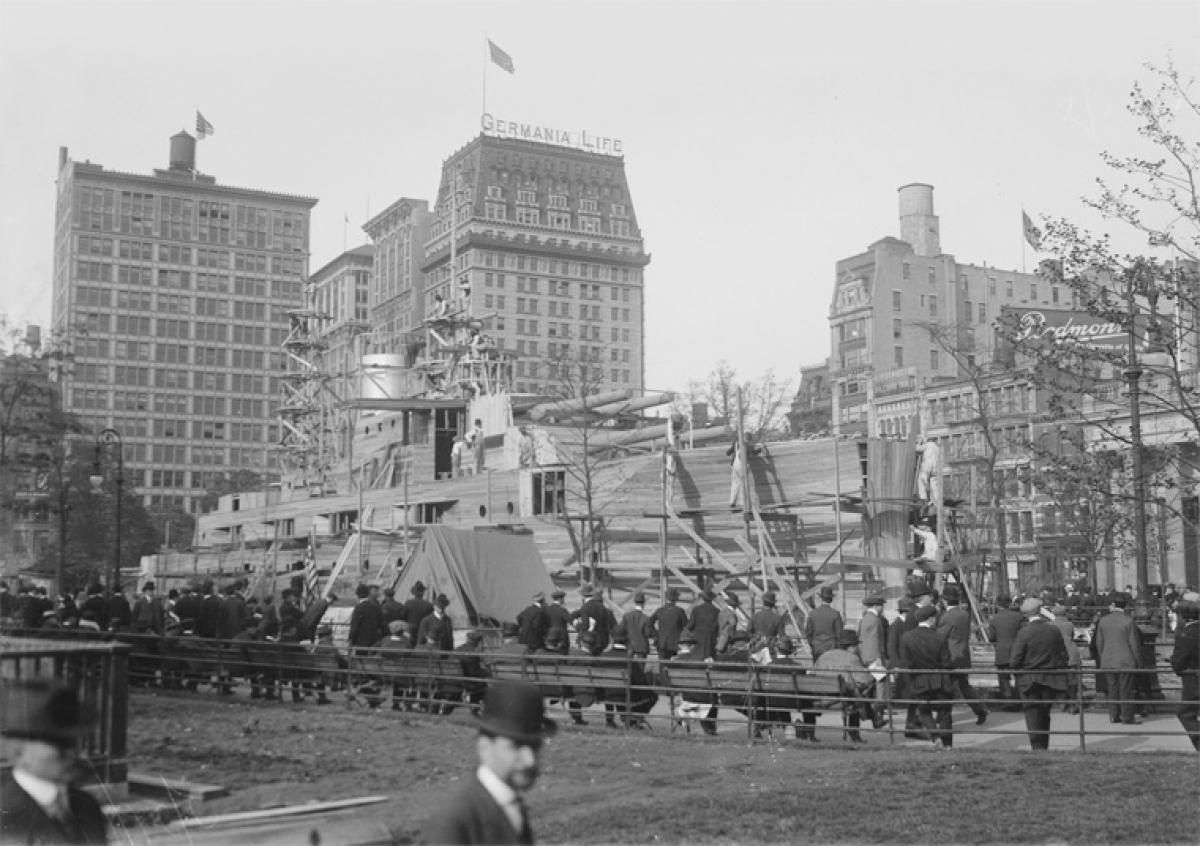How do you get 25,000 New Yorkers to enlist for Navy sea duty amid the horror of World War I? Give them a look at sailor life by building and manning a faux battleship in Manhattan’s bustling Union Square.
The USS Recruit featured six 14-inch guns housed in three twin turrets, ten 5-inch guns, and two cage masts. Contemporaneous news reports referred to the wooden battlewagon as being commissioned by the Navy, but supporting evidence from the service is elusive. Nevertheless, the Navy built the Recruit and used her as a recruiting station and training vessel.
The idea was the brainchild of New York City Mayor John P. Mitchel.1 The city had been lagging behind in recruiting sailors for the Navy. Its goal was 2,000 recruits, but only 900 had volunteered. Mitchel needed something to spark interest—like a battleship built in the middle of the city. Designers Donn Barber and Jules Guerin loosely based the vessel on the Navy’s battleship Maine, and she was “launched” in Union Square on 30 May 1917, seven weeks after the United States entered World War I.
With a length of 250 feet and a beam of 40 feet, the Recruit was half the size of a World War I–era Nevada-class super-dreadnought battleship. She looked authentic, was manned around the clock by sailors from Newport Training Station, and was fitted out like the real deal with a wireless station, full officers’ quarters, doctors’ quarters, and examination rooms for recruits.2 Her armament was designed to match that of the Nevadas.
The Recruit had the distinction of also being the first Navy ship to be heated by natural gas, piped in from a city gas company.3 A journalist for American Gas Engineering Journal described the scene on visiting the battleship:
To the passerby the good ship Recruit may seem just an empty hulk but watching a few minutes will invariably show up some of its regular jackie crew somewhere on deck doing part of the inevitable polishing and scrubbing or perhaps a door in the ship’s hold will open and the Navy band consisting of thirty-six pieces will start out on their morning or afternoon recruiting. Besides thirty-six band members there is a crew of fifty-five men detailed from Newport or other naval training stations all of whom are leading as near a sea life as can be approximated with skyscrapers looking down upon them from all four sides.4
Near-regular Navy routine was the norm on board the Recruit. The sailors-in-training rose at 0600, scrubbed the decks, did their laundry, and attended classes. They also stood guard, during which time they were available to answer questions from visitors. At night searchlights and all the ship’s lights illuminated the scene. Many social functions occurred on board.
Mid-war, the Camouflage Corps of the National League for Woman’s Service repainted the ship at the request of her commander to make her more lifelike in a combat zone.5 The women used black, white, pink, green, and blue, arranged in a camouflage pattern used by the Navy to avoid submarines.
The ship was an astounding success in her appointed role. Recruitment rates jumped 25-fold in her three years of duty to more than 25,000. Upon the Recruit’s “decommissioning” in 1920, The New York Times reported that she had finally “set sail. . . . The crew of eighty men lined up on the quarterdeck and the ship was formally abandoned while the Stars and Stripes and commissioned pennant were hauled down. The ship’s band struck up ‘The Star-Spangled Banner’ as the colours were lowered to the deck.”6
The Recruit had been so successful in her mission that plans were made for her to drop anchor in Brooklyn’s Coney Island, where she would serve as a permanent Navy recruitment station. The ship was disassembled; however, the change of station never took place, and the fate of the landship remains unknown. As for Mayor Mitchel, he didn’t get a political lift from the ship. Losing his re-election bid, he joined the Army Air Corps in 1918 and died in a training accident.7
1. “A Battleship in Union Square: the ‘USS’ Recruit, 1917, & the Invention of the Word ‘Landship,’” JF Ptak Science Books, http://longstreet.typepad.com/thesciencebookstore/2009/03/a-battleship-in-union-square-the-uss-recruit-1917-the-invention-of-the-word-landship.html.
2. “The ‘Recruit’: Our Only Land Battleship,” Popular Mechanics, vol. 91, no. 2 (August 1917), 213.
3. “New York City Boasts of First Gas-Heated Battleship,” American Gas Engineering Journal, vol. 107, no. 22 (1 December 1917), 507, 509.
4. Ibid.
5. “Camouflage the Recruit: Women’s Service Corps Redecorate the Landship in Union Square,” The New York Times, 12 July 1918.
6. “Landship Recruit sails; ceremonies mark beginning of Union-Square Coney Island cruise,” The New York Times, 17 March 1920.
7. “A Battleship in Union Square.”



